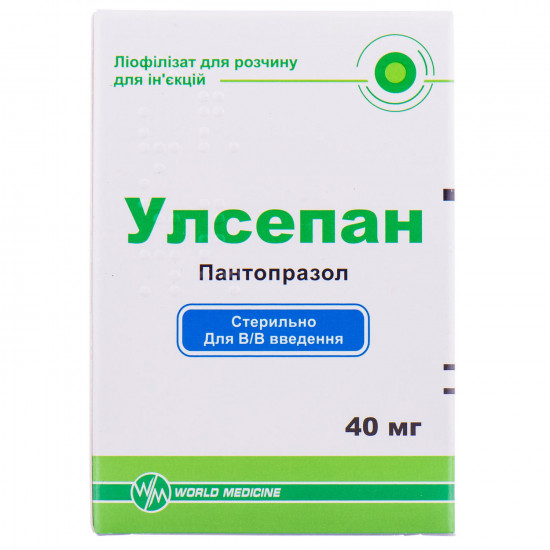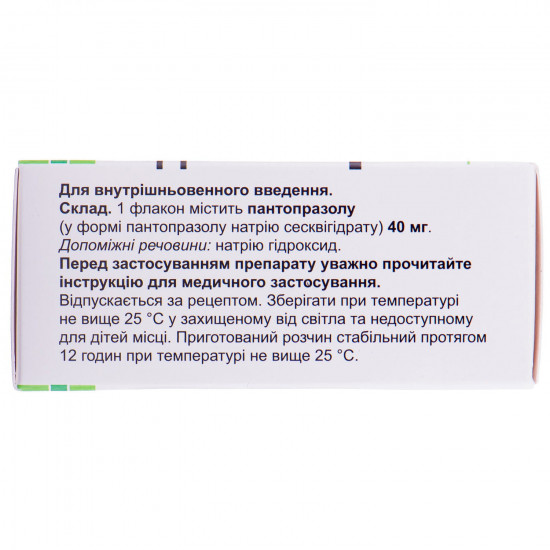



- Stock: In Stock
- Model: 184730
0% Customers recommend this product
-
5 Awesome0%
-
4 Great0%
-
3 Average0%
-
2 Bad0%
-
1 Poor0%
Reviews Over Ulsepan liofit. for solution for infection. 40 mg fl. No. 1
- (0)
Total Reviews (0)
click here write review to add review for this product.
Report this review.
Description
Pharmacological properties
Pharmacodynamics. pantoprazol — the substituted benzimidazole which inhibits secretion of hydrochloric acid in a stomach by specific blockade of a proton pomp of covering cells.
Pantoprazol is transformed byto an active form in acidic environment in covering cells where inhibits H enzyme + - K + - to ATFaz, that is blocks a final stage of production of hydrochloric acid in a stomach. The inhibition depends on a dose and suppresses both basal, and stimulated secretion of acid. At most of patients the symptoms disappear during 2 weeks. Use of a pantoprazol, as well as other inhibitors of a proton pomp (IPP) and H 2 inhibitors - receptors, reduces acidity in a stomach and thus increases secretion of gastrin in proportion to decrease in acidity. Increase in secretion of gastrin is reversible. As pantoprazol connects enzyme distally of rather cellular receptor, it can inhibit secretion of hydrochloric acid irrespective of stimulation by other substances (acetylcholine, a histamine, gastrin). The effect at peroral and in in use is identical.
Pharmacokinetics
Absorption. Pantoprazol is quickly soaked up, and the C max in blood plasma is reached after single dose of a dose of 40 mg. On average in 2.5 h after reception of the C max in blood plasma it is reached at the level of about 2-3 mkg/ml; concentration remains at the constant level after multiple dose. Pharmacokinetic properties do not change after single or repeated dose. In the range of doses of 10-80 mg the pharmacokinetics of a pantoprazol in blood plasma remains linear both at oral administration, and at in in introduction. It is established that the absolute bioavailability of tablets is about 77%. The concomitant use of food does not influence AUC or C max in blood plasma, and, respectively, and bioavailability. At a concomitant use of food only the variability of stage of latency increases.
Distribution. Linking of a pantoprazol with proteins of blood plasma makes about 98%. The volume of distribution is about 0.15 l/kg of body weight.
Biotransformation. Substance is metabolized almost only in a liver. The main metabolic way is demethylation by means of CYP 2C19 with the subsequent sulphatic conjugation; oxidation by means of CYP 3A4 belongs to other metabolic ways.
Removal. Final T ½ makes about 1 h, and clearance — 0.1 l/h/kg. Several cases of a delay of removal are noted. Owing to specific linking of a pantoprazol with a proton pomp of T ½ covering cells does not correlate with much longer duration of action (acid secretion inhibition).
Main part of metabolites of a pantoprazol is removed bywith urine (about 80%), the rest is removed with a stake. The main metabolite both in blood plasma, and in urine is desmetilpantoprazol, conjugated with sulfate. T ½ main metabolite (about 1.5 h) not much more exceeds T ½ a pantoprazola.
For adults and children 12 years are aged more senior than
Indication: reflux esophagitis.
For adults:
- an eradikation of Helicobacter pylori (H. pylori) at patients with H. the pylori-associated ulcers of stomach and duodenum in combination with the corresponding antibiotics;
- duodenum ulcer;
- stomach ulcer;
- Zollinger's syndrome — Ellisona and other hyper secretory morbid conditions.
Use
Tablet:
medicament is intended to- for oral administration. A pill should be taken 1 h to food entirely, without chewing and without crushing, washing down with water.
Adults and children are aged more senior than 12 years
Treatment a reflux esophagitis. The recommended dose makes 40 mg (1 tablet) of 1 times a day. In some cases a dose it is possible to double to 80 mg/days (2 tablets), especially in the absence of effect of use of other medicaments for treatment a reflux esophagitis. For treatment the reflux esophagitis, as a rule, is required to 4 weeks. If it is not enough, treatment can be expected during the following 4 weeks
Adult
Eradikation'sH. pylori in a combination with two antibiotics. At adult patients with ulcer of stomach and duodenum and positive take on H. pylori the eradikation of a microorganism needs to reach by means of combination therapy. It is necessary to consider local data on bacterial resistance and national recommendations about use and prescribing of the appropriate antibacterial agents. Depending on sensitivity of microorganisms for an eradikation of H. pylori at adults such therapeutic combinations can be appointed:
a) of 40 mg of a pantoprazol (1 tablet) 2 times a day
+ 1000 mg of amoxicillin 2 times a day
+ 500 mg of a klaritromitsin 2 times a day;
b) of 40 mg of a pantoprazol (1 tablet) 2 times a day
+ 400–500 mg of metronidazole (or 500 mg of Tinidazolum) 2 times a day
+ 250–500 mg of a klaritromitsin 2 times a day;
c) of 40 mg of a pantoprazol (1 tablet) 2 times a day
+ 1000 mg of amoxicillin 2 times a day
+ 400–500 mg of metronidazole (or 500 mg of Tinidazolum) 2 times a day.
At use of combination therapy for an eradikation of H. pylori the second pill of a pantoprazol should be taken in the evening for 1 h to food. The period of treatment is 7 days and can be prolonged for 7 days (the general duration of treatment no more than 2 weeks). If for ensuring healing of an ulcer the further therapy pantoprazoly is shown, it is necessary to consider recommendations concerning dosing in ulcer of stomach and duodenum.
If combination therapy is not shown to, for example at patients with negative take on H. pylori, for monotherapy appoint Ulsepan in the following mode of dosing.
Treatment of stomach ulcer. The recommended dose of 40 mg (1 tablet) in day. In some cases it is possible to double a dose to 80 mg (2 tablets a day), especially in the absence of effect of use of other drugs. Treatment of stomach ulcer, as a rule, requires 4 weeks. If it is not enough, treatment can be expected during the following 4 weeks
Treatment of an ulcer of a duodenum. The recommended dose of 40 mg (1 tablet) in day. In some cases it is possible to double a dose to 80 mg (2 tablets) a day, especially in the absence of effect of use of other drugs.
toFor treatment of an ulcer of a duodenum, as a rule, needs 2 weeks. If it is not enough, treatment can be expected during the following 2 weeks
Treatment at Zollinger's syndrome — Ellisona and other hyper secretory morbid conditions. For long-term treatment at Zollinger's syndrome — Ellisona and other morbid hyper secretory conditions the initial daily dose makes 80 mg (2 tablets) a day. If necessary after that the dose can be titrated, raising or reducing depending on indicators of secretion of acid in a stomach. If the dose exceeds 80 mg/days, it needs to be divided into 2 receptions. Perhaps temporary increase in a dose to more than 160 mg of a pantoprazol, but duration of use has to be limited only to the period necessary for adequate control of secretion of acid.
totreatment Duration at Zollinger's syndrome — Ellisona and other morbid conditions is not limited and depends on clinical need.
Patients with an abnormal liver function. Patients with heavy abnormal liver functions should not exceed a daily dose of a pantoprazol of 20 mg. Patients with abnormal liver functions of average and heavy degree should not use medicament for H eradikation. pylori in combination therapy as there are no data on efficiency and safety of such use for this category of patients now.
Patients with a renal failure. For patients with impaired renal function of dose adjustment it is not required. Patients with impaired renal function should not use medicament for an eradikation of H. pylori in combination therapy as there are no data on efficiency and safety of such use for this category of patients now.
Patients of advanced age. Dose adjustment is not required.
Children. Drug is shown to children aged 12 years for treatment a reflux esophagitis are more senior. Drug is not recommended to be used at children aged up to 12 years as data on safety and efficiency of medicament for this age category are limited.
Lyophilisate for solution for injections: medicament is used the adult according to purpose and under direct observation of the doctor. In/in use of medicament it is recommended only in case of impossibility of oral administration. Available data on safety concern in/in uses during up to 7 days. Therefore at a clinical opportunity the transition from in/in introductions of a pantoprazol to oral administration of a pantoprazol in a dose of 40 mg is carried out.
Dosing
Treatment a reflux esophagitis, ulcers of a duodenum, stomach ulcer
use Drug in a dose 40 mg (1 bottle) a day in / century
Treatment at Zollinger's syndrome — Ellisona and other hyper secretory morbid conditions
use Drug in the recommended initial dose 80 mg/days. If necessary the dose can be titrated, raising or reducing depending on indicators of secretion of acid in a stomach. The doses exceeding 80 mg/days need to be divided into two introductions. Perhaps temporary increase in a dose of a pantoprazol more than 160 mg, but duration of use has to be limited only to the period necessary for adequate control of secretion of acid.
in case of a nebkhodimost of fast decrease in acidity, to most of patients of rather initial dose of 80 mg 2 times for achievement of desirable level (10 mekv / h) during 1 h
Liver failure. Patients with heavy abnormal liver functions should not exceed a daily dose of 20 mg (½ bottles of drug).
Renal failure. Patients with renal failures do not need dose adjustment.
Patients of advanced age. There is no need for dose adjustment.
Route of administration. Powder dissolve 0.9% of solution of sodium chloride in 10 ml. Solution can be entered directly or after mixing from 100 ml of 0.9% of solution of sodium chloride or 5% of solution of glucose in plastic or glass bottles.
Prepared solution is stableduring 12 h at a temperature not above 25 °C.
However taking into account maintaining microbiological purity recommends to usedivorced medicament immediately.
Drug cannot be prepared or mixed with other solvents, except above-stated.
Administration of medicament needs to be executed within 2–15 min.
Bottle is intended only for single use. Before use it is necessary to check visually bottles with medicament (in particular concerning discoloration, existence of a deposit).
Diluted solution has to be colourless or weak-yellow.
Children. Drug is not recommended to be used to children (aged up to 18 years) as data on safety and efficiency of a pantoprazol for this age category are limited. The data which are available for today are described in Pharmacokinetics, however recommendations about dosing cannot be provided.
Contraindication
Hypersensitivity to active agent, derivatives of benzimidazole or any component of drug.
Side effects
Most frequent side reactions arising at use of a pantoprazol — diarrhea and a headache (approximately at 1% of patients).
Side effects on the frequency of emergence classifyby such categories: very often (≥1/10), it is frequent (≥1/100 and 1/10), infrequently (≥1/1000 and 1/100), is rare (≥1/10,000 and 1/1000), is very rare (1/10,000), it is unknown (frequency is not determined by the available data).
frequency of side reactions is specified bywithin each category in decreasing order of gravity.
All side reactions about which reported during the post-marketing period and cannot determine their frequency, specify in category it is unknown.
from blood and lymphatic system: seldom — an agranulocytosis; very seldom — a leukopenia, thrombocytopenia, a pancytopenia.
from the immune system: seldom — reactions of hypersensitivity (including anaphylactic reactions, an acute anaphylaxis).
Metabolism and disbolism: seldom — a lipidemia and increase in level of lipids (TG, XC), changes of body weight; it is unknown — a hyponatremia, a hypomagnesiemia (see. Special INSTRUCTIONS), hypocalcemia 1 , hypopotassemia.
Mental disorders: infrequently — sleep disorders; seldom — a depression (including aggravations); very seldom — a disorientation (including aggravations); it is unknown — hallucinations, confusion of consciousness (especially at patients with tendency to these disorders and also aggravation of these symptoms in case of existence them in the anamnesis).
from nervous system: infrequently — a headache, dizziness; seldom — disturbances of taste; it is unknown — paresthesias.
from an organ of sight: seldom — disturbance sight/misting of sight.
from a digestive tract: often — polyps of fundal glands (benign); infrequently — diarrhea, nausea, vomiting, an abdominal distension, a constipation, dryness in a mouth, an abdominal pain and discomfort.
from a gepatobiliarny system: infrequently — increase in level of liver enzymes (transaminases, a γ-glutamiltransferaza); seldom — increase in level of bilirubin; it is unknown — damage of hepatocytes, jaundice, hepatocellular insufficiency.
from skin and hypodermic fabrics: infrequently — skin rash, a dieback, an itching; seldom — urticaria, a Quincke's disease; it is unknown — Stephens's syndrome — Johnson, a Lyell's disease, a multiformny erythema, photosensitivity, a subacute skin lupus erythematosus.
from a musculoskeletal system and connective tissue: infrequently — fractures of a hip, wrist, backbone (see. Special INSTRUCTIONS); seldom — an arthralgia, myalgia; it is unknown — a spasm of muscles 2 .
from kidneys and an urinary system: it is unknown — interstitial nephrite (with possible development of a renal failure).
from a reproductive system and mammary glands: seldom — a gynecomastia.
General disorders: often — thrombophlebitis in the injection site; infrequently — an asthenia, fatigue, an indisposition; seldom — fervescence, peripheral hypostases.
1 Hypocalcemia along with a hypomagnesiemia.
2 Spasm of muscles as a result of disturbance of balance of electrolytes.
Special instructions
Malignant new growths of a stomach. the symptomatic response to use of a pantoprazol can mask symptoms of malignant new growths of a stomach and postpone their diagnostics. in the presence of disturbing symptoms (for example at significant loss of body weight, periodic vomitings, dysphagies, vomitings with blood, anemias, melenas) and also at suspicion or presence of stomach ulcer it is necessary to exclude existence of malignant process.
If symptoms remain at adequate treatment, it is necessary to perform additional examination.
Prolonged use of drug. At prolonged use of drug, especially more than 1 year, patients have to be under regular observation of the doctor.
Abnormal liver function. Patients with heavy abnormal liver functions need to control regularly the level of liver enzymes, especially at long-term treatment. At increase in level of liver enzymes the therapy is required to be stopped.
Use as a part of combination therapy. At use of medicament as a part of combination therapy it is necessary to follow instructions for medical use of the corresponding medicines.
Existence of disturbing symptoms. In the presence of disturbing symptoms (for example in case of significant degrowth of a body, periodic vomiting, a dysphagy, vomiting with blood, anemias, melenas) and also at suspicion or presence of stomach ulcer it is necessary to exclude existence of malignant process as treatment pantoprazoly can mask symptoms and delay establishment of the diagnosis.
If symptoms remain at adequate treatment, it is necessary to perform additional examination.
HIV protease Inhibitors. The combined use of a pantoprazol with HIV protease inhibitors is not recommended (such as atazanavir) which absorption depends on an intragastric rn, because of significant decrease in their bioavailability.
Influence on absorption of 12 vitamin B . At patients with Zollinger's syndrome — Ellisona and other hyper secretory morbid conditions demanding long-term treatment, pantoprazol as well as all medicaments blocking products of hydrochloric acid can reduce absorption of 12 vitamin B (cyanocobalamine) in connection with emergence hypo - and achlorhydrias. It should be considered at the reduced body weight at patients or presence of risk factors of decrease in absorption of 12 vitamin B at long-term treatment or existence of the corresponding clinical symptoms.
Infection of a digestive tract, caused by bacteria. Pantoprazol, as well as other IPP, can increase quantity of bacteria which usually are present at upper parts of a digestive tract. Use of a pantoprazol can increase several risk of developing of the gastrointestinal infections caused by such bacteria as Salmonella and Campylobacter or C. difficile.
Hypomagnesiemia. Noted cases of a heavy hypomagnesiemia at the patients receiving IPP, such as pantoprazol, within not less than 3 months, and in most cases during 1 year. Can arise and at first imperceptibly develop the following serious clinical manifestations of a hypomagnesiemia: fatigue, tetany, delirium, spasms, dizziness and ventricular arrhythmia. At a hypomagnesiemia in most cases the condition of patients improved after replacement corrective therapy by medicaments of magnesium and the termination of reception of IPP.
to Patients who need long therapy or to the persons accepting IPP along with digoxin or medicaments which can cause a hypomagnesiemia (for example diuretics) needs to determine bymagnesium level before an initiation of treatment of IPP and periodically during treatment.
Bone fractures. Long-term treatment (more than 1 year) IPP in high doses can slightly increase risk of a fracture of hip, wrist and backbone, mainly at elderly people or with other risk factors. Observation researches demonstrate that use of IPP can increase the general risk of changes by 10–40%. Some of them can be caused by other risk factors. Patients with risk of developing osteoporosis have to receive treatment according to the existing clinical recommendations and use enough vitamin D and calcium.
Subacute skin lupus erythematosus. Use of IPP is connected with very exceptional cases of development of a subacute skin lupus erythematosus. If there is a defeat, especially on the sites which are affected by sunlight and it is followed by an arthralgia, the patient needs to see a doctor who will consider need of medicament withdrawal immediately. Emergence of a subacute skin lupus erythematosus at patients during the previous therapy of IPP can increase risk of its development at use of other IPP.
Influence on results of laboratory researches. The increased CgA level can affect results of researches at diagnosis of neuroendocrinal tumors. To avoid such influence, use of medicament should be stopped temporarily at least in 5 days prior to evaluating the CgA level. If the CgA levels and gastrin were not normalized after initial measurement, it is necessary to take repeated measurements in 14 days after cancellation of treatment of IPP.
Lyophilisate for solution for injections: medicament contains less than 1 mmol (23 mg) / a sodium dose, that is almost free from sodium.
Use during pregnancy or feeding by a breast
Pregnancy. Experience of use of medicament for pregnant women is limited. During the researches of reproductive function on animals the reproductive toxicity is revealed. The potential risk for the person is unknown. Drug should not be used during pregnancy, except emergency cases.
Feeding by a breast. Tests on animals showed removal of a pantoprazol with breast milk. There are data on excretion of a pantoprazol with breast milk of the person. The decision on the feeding termination by a breast or termination/abstention from medicament treatment has to be accepted taking into account a ratio of advantage of feeding by a breast for the child and advantage of treatment pantoprazoly for the woman.
Ability to influence speed of response at control of vehicles or work with other mechanisms. It is necessary to take possible development of side reactions, such as dizziness and visual disturbances into account. In such cases it is not necessary to run vehicles or to work with mechanisms.
Interaction
Medicines which absorption depends from rn. as a result of complete and long inhibition of secretion of hydrochloric acid pantoprazol can influence absorption of medicaments for which the value rn gastric juice is an important factor of their bioavailability (for example some antifungal drugs, such as ketokonazol, itrakonazol, pozakonazol or other drugs, such as erlotinib).
HIV protease Inhibitors. The combined use of a pantoprazol with HIV protease inhibitors is not recommended (such as atazanavir) which absorption depends on an intragastric rn, because of significant decrease in their bioavailability. If the combined use of inhibitors of HIV protease with IPP cannot be avoided, careful clinical monitoring is recommended (for example viral load). It is not necessary to exceed a daily dose of a pantoprazol of 20 mg. There can be a need of dose adjustment of inhibitors of HIV protease.
Coumarinic anticoagulants (fenprokumon and warfarin). Despite the lack of interaction at simultaneous use with fenprokumony and warfarin during conduct of clinical trials, isolated cases of change of the international normalized relation (INR) during the post-marketing period are registered. Thus, to the patients applying indirect anticoagulants (for example fenprokumon and warfarin), it is recommended to carry out monitoring of a prothrombin time / MNO after the beginning, the terminations or at irregular reception of a pantoprazol.
Methotrexate. It was reported that simultaneous use of a methotrexate in high doses (for example 300 mg) and IPP increases methotrexate level in blood at some patients. The patients accepting a methotrexate in vysokiyekh doses, for example the cancer patient or psoriasis are recommended to stop temporarily treatment pantoprazoly.
Other interactions. Pantoprazol is substantially metabolized in a liver through the system of enzymes of P450 cytochrome. The main way of metabolism — demethylation by means of CYP 2C19 and other metabolic ways, including oxidation by CYP enzyme 3A4. Researches with medicines which are also metabolized by means of these ways such as carbamazepine, diazepam, glibenclamide, nifedipine and oral contraceptives containing levonorgestrel and ethinylestradiol did not reveal clinically significant interactions.
Results of a number of researches on studying possible interactions specify that pantoprazol does not influence metabolism of active agents which are metabolized by means of CYP 1A2 (for example caffeine, theophylline), CYP 2C9 (for example piroxicam, diclofenac, Naproxenum), CYP 2D6 (for example metoprolol), CYP 2E1 (for example ethanol), does not influence a p-glycoprotein which is associated with digoxin absorption.
bydid not reveal interaction with at the same time appointed antacids.
byconducted researches on studying interaction of a pantoprazol with at the same time applied certain antibiotics (klaritromitsin, metronidazole, amoxicillin). Clinically significant interactions between these medicaments are not revealed.
Overdose toSymptoms of overdose are unknown to
. at in in introduction within 2 min. were well transferred by
Dose up to 240 mg. As pantoprazol extensively contacts proteins, it does not belong to medicaments which can be removed easily by means of dialysis.
in case of overdose at emergence of clinical signs of intoxication perform symptomatic and maintenance therapy. There are no recommendations about specific therapy.
Storage conditions
At a temperature not above 25 °C in the dry, protected from light place.
Specifications
| Characteristics | |
| Active ingredients | Pantoprazol |
| Amount of active ingredient | 40 mg |
| Applicant | World Medicine |
| Code of automatic telephone exchange | A02BC02 Pantoprazol |
| Interaction with food | It doesn't matter |
| Light sensitivity | Sensitive |
| Market status | The branded generic |
| Origin | Chemical |
| Prescription status | According to the prescription |
| Primary packing | bottle |
| Producer | SAN MEFAR ILACH. A.SH. |
| Quantity in packing | 1 pieces. |
| Release form | powder for injections |
| Route of administration | Infusional |
| Sign | Import |
| Storage temperature | from 5 °C to 25 °C |
| Trade name | Ulsepan |













































